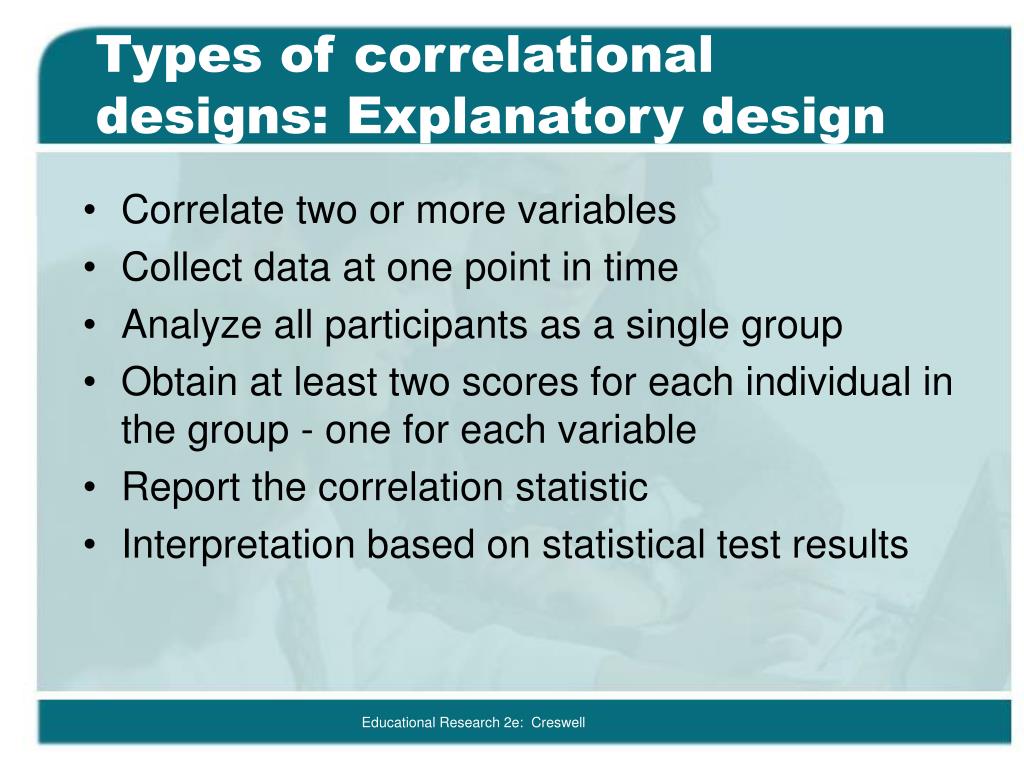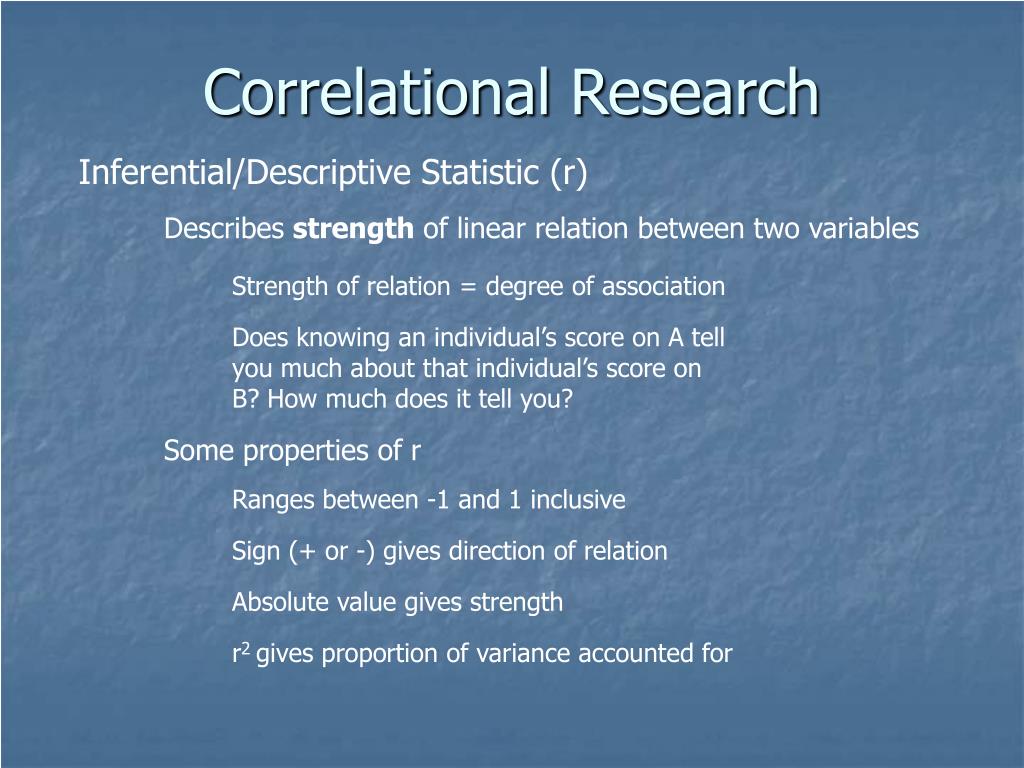Table Of Content

This means that as one variable increases, the other variable also tends to increase. Similarly, as one variable decreases, the other variable also tends to decrease. For example, there is a positive correlation between the amount of time spent studying and academic performance. The more time a student spends studying, the higher their academic performance is likely to be. Similarly, there is a positive correlation between a person’s age and their income level. There are many other variables that may influence both variables, such as average income, working conditions, and job insecurity.
Data Collection Methods
Correlational research is a type of nonexperimental research in which the researcher measures two variables and assesses the statistical relationship (i.e., the correlation) between them with little or no effort to control extraneous variables. There are essentially two reasons that researchers interested in statistical relationships between variables would choose to conduct a correlational study rather than an experiment. The first is that they do not believe that the statistical relationship is a causal one.
Scatterplots
Another potential benefit is that these sources often provide an enormous amount of data that was collected over a very long period of time, which can give researchers a way to view trends, relationships, and outcomes related to their research. Surveys and questionnaires are some of the most common methods used for psychological research. The survey method involves having a random sample of participants complete a survey, test, or questionnaire related to the variables of interest. Factor analysis is a statistical method used to identify patterns among variables. Researchers use factor analysis to group variables into factors that are related to each other.
What is Correlational Research? (+ Design, Examples)
Such considerations must be incorporated in all types of correlational research design. Correlation research design is used when experimental studies are difficult to design. It is best to conduct correlational research using an online correlational research survey form as this makes the data-gathering process, more convenient.
Methodology

In addition, the researcher would be able to reach out to more survey respondents than is plausible with printed correlational research survey forms. You think that how much people earn hardly determines the number of children that they have. Yet, carrying out correlational research on both variables could reveal any correlational relationship that exists between them. Archival data is a type of correlational research method that involves making use of already gathered information about the variables in correlational research. Since this method involves using data that is already gathered and analyzed, it is usually straight to the point. Essentially, there are 3 types of correlational research which are positive correlational research, negative correlational research, and no correlational research.
Institutional Review Board – Application Sample...
A scatterplot is a graphical representation of the relationship between two variables. The x-axis represents one variable, and the y-axis represents the other variable. The pattern of data points on the plot can provide insights into the strength and direction of the relationship between the two variables. Correlational research is a type of research design commonly used in the social and behavioral sciences. A meta-analysis is a formal, epidemiological, quantitative study design that uses statistical methods to generalise the findings of the selected independent studies. One of the most popular methods of conducting correlational research is by carrying out a survey which can be made easier with the use of an online form.
Psychological Correlational Studies
Understanding these key concepts will enable you to interpret correlation coefficients accurately and draw meaningful conclusions from your data. The direction of correlation determines how the variables change relative to each other. A person might answer a particular way to try to please the researchers or to try to control how the researchers perceive them (such as trying to make themselves "look better"). For one, the data is not always reliable—particularly if the survey questions are poorly written or the overall design or delivery is weak. Data is also affected by specific faults, such as unrepresented or underrepresented samples. If researchers need to gather a large amount of data in a short period of time, a survey is likely to be the fastest, easiest, and cheapest option.
Correlations that are a result not of the two variables being measured, but rather because of a third, unmeasured, variable that affects both of the measured variables. Nielsen, Halamka, and Kinkel (2012) conducted a case-control study to evaluate whether there was an association between active Internet patient portal use by Multiple Sclerosis (ms) patients and medical resource utilization. Linder, Schnipper, and Middleton (2012) conducted a cross-sectional study to examine the association between the type of ehr documentation used by physicians and the quality of care provided. Shamliyan, Kane, and Dickinson (2010) conducted a systematic review on tools used to assess the quality of observational studies. Despite the large number of quality scales and checklists found in the literature, they concluded that the universal concerns are in the areas of selection bias, confounding, and misclassification.
II. Chapter 2: Overview of the Scientific Method
You can observe people and gather information from them in various public places such as stores, malls, parks, playgrounds, etc. The major difference between correlational research and experimental research is methodology. In correlational research, the researcher looks for a statistical pattern linking 2 naturally-occurring variables while in experimental research, the researcher introduces a catalyst and monitors its effects on the variables.
To strengthen causal inferences in correlational research, researchers can employ longitudinal designs, experimental methods (when ethical and feasible), and theoretical frameworks to guide their interpretations. Determining the statistical significance of the correlation coefficient involves conducting hypothesis testing to assess whether the observed correlation is likely to occur by chance. The most common approach is to use a significance level (alpha, α) of 0.05, which corresponds to a 5% chance of obtaining the observed correlation coefficient if there is no true relationship between the variables. The strength of correlation refers to how closely the data points cluster around a straight line on the scatterplot.
4 Reasons why Correlation does NOT imply Causation by Ines Lee - Towards Data Science
4 Reasons why Correlation does NOT imply Causation by Ines Lee.
Posted: Sun, 18 Apr 2021 07:00:00 GMT [source]
While correlational studies can identify relationships between variables, they cannot determine causality. This is because correlation merely describes the degree to which two variables co-vary; it does not establish a cause-and-effect relationship between them. Meta-analysis involves combining and analyzing the results of multiple studies to explore the relationships between variables across different contexts and populations. Meta-analysis is useful for identifying patterns and inconsistencies in the literature and can provide insights into the strength and direction of relationships between variables. The 3 methods of data collection in correlational research are naturalistic observation method, archival data method, and the survey method. For example, a marketing correlational study might explore the relationship between social media engagement and brand loyalty among millennials.
The correlation between 2 variables changes on a daily basis and such, it cannot be used as a fixed data for further research. This method is very flexible as researchers can gather large amounts of data in very little time. However, it is subject to survey response bias and can also be affected by biased survey questions or under-representation of survey respondents or participants. Zero correlational research is a type of correlational research that involves 2 variables that are not necessarily statistically connected. In this case, a change in one of the variables may not trigger a corresponding or alternate change in the other variable.
While correlational research provides valuable insights into associations and patterns, establishing causation typically requires additional evidence from experimental studies or other research designs. Correlational research design is used to determine if there is a relationship between two or more variables. This type of research design involves collecting data from participants and analyzing the relationship between the variables using statistical methods. The aim of correlational research is to identify the strength and direction of the relationship between the variables. Correlational studies are different from comparative studies in that the evaluator does not control the allocation of subjects into comparison groups or assignment of the intervention to specific groups.
This means that it is important to make a scatterplot and confirm that a relationship is approximately linear before using Pearson’s r. Nonlinear relationships are fairly common in psychology, but measuring their strength is beyond the scope of this book. Another example of a marketing correlational study could focus on investigating the relationship between pricing strategies and customer satisfaction in the retail sector. By analyzing data on pricing fluctuations, customer feedback, and sales performance, researchers can assess whether pricing strategies such as discounts or promotions impact customer satisfaction and repeat purchase behavior. Correlational research is also widely utilized in the business and management fields to explore relationships between organizational variables and outcomes. By examining correlations between different factors within an organization, researchers can identify patterns and trends that may impact performance, productivity, and profitability.
By collecting data on millennials' social media usage, brand interactions, and purchase behaviors, researchers can analyze whether higher levels of social media engagement correlate with increased brand loyalty and advocacy. Correlational research is widely used across various disciplines to explore relationships between variables and gain insights into complex phenomena. We'll examine examples and applications of correlational studies, highlighting their practical significance and impact on understanding human behavior and societal trends across various industries and use cases.
A correlation coefficient close to -1 or +1 indicates a strong relationship between the variables, while a coefficient close to 0 suggests a weak relationship. Naturalistic observation is a way of data collection in which people’s behavioral targeting is observed in their natural environment, in which they typically exist. It could mean a researcher might be observing people in a grocery store, at the cinema, playground, or in similar places. The distinctive feature of correlational research is that the researcher can’t manipulate either of the variables involved.

No comments:
Post a Comment